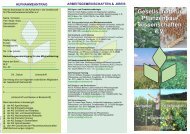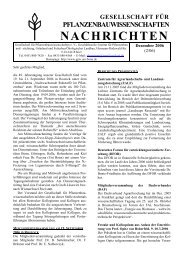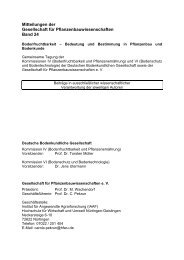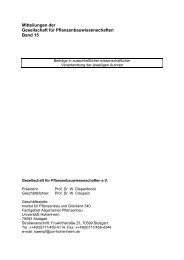Mitteilungen der Gesellschaft für Pflanzenbauwissenschaften Band 23
Mitteilungen der Gesellschaft für Pflanzenbauwissenschaften Band 23
Mitteilungen der Gesellschaft für Pflanzenbauwissenschaften Band 23
Erfolgreiche ePaper selbst erstellen
Machen Sie aus Ihren PDF Publikationen ein blätterbares Flipbook mit unserer einzigartigen Google optimierten e-Paper Software.
Mitt. Ges. Pflanzenbauwiss. <strong>23</strong>: 153 (2011)<br />
Exploring the role of poly(ADP-ribose)polymerases in plants<br />
Dagmar Rissel 1,2 , Kathrin Thor 2 and Edgar Peiter 2<br />
1 Agrochemisches Institut Piesteritz e. V., Lutherstadt Wittenberg; 2 Plant Nutrition Laboratory, IAEW,<br />
Universität Halle-Wittenberg. E-Mail: dagmar.rissel@landw.uni-halle.de<br />
Introduction<br />
Poly(ADP-ribosyl)ation is a fast transient posttranslational protein modification.<br />
Activated upon DNA strand breaks, poly(ADP-ribose) polymerases (PARPs) add<br />
ADP-ribose molecules to nuclear proteins involved in DNA strand break repair<br />
mechanisms. Thereby NAD + is used as a substrate to build up ADP-ribose polymers.<br />
In the model plant Arabidopsis thaliana three PARP genes (AtPARP1, AtPARP2 and<br />
AtPARP3) have been identified. Recent studies suggest a role of poly(ADPribosyl)ation<br />
in the plant response to abiotic stress (De Block et al. 2005;<br />
Van<strong>der</strong>auwera et al. 2007): Plants with reduced expression of AtPARP1 and<br />
AtPARP2 were shown to have an increased tolerance towards drought stress and<br />
oxidative stress induced by reactive oxygen species (ROS) [1]. However, the<br />
mechanisms of how PARPs are involved in plant stress responses are still a matter<br />
of debate.<br />
Material and Methods<br />
To elucidate the role of PARPs in plant stress response Arabidopsis parp knockout<br />
mutants were cultured on agar plates containing mannitol (drought stress), NaCl or<br />
methyl viologen (oxidative stress). During culture the root length of mutant and wild<br />
type plants was measured. After culture root and shoot fresh weight of the plants was<br />
determined. The parp single mutants were crossed with each other to create double<br />
knockout mutants. Homozygous F2 plants are currently being analysed for their<br />
stress tolerance. Apart form that seed germination of parp mutants was scored on<br />
agar plates.<br />
Results and Discussion<br />
Arabidopsis PARPs have been suggested to be involved in plant stress response.<br />
Surprisingly, in our hands parp single mutants did not display any enhanced stress<br />
tolerance so far. Since PARP genes may be functionally redundant, parp single<br />
mutant lines were crossed to create double mutants. The abiotic stress tolerance of<br />
these plants is currently un<strong>der</strong> investigation. Interestingly, parp single mutants<br />
showed a delay in germination un<strong>der</strong> standard growth conditions. After artificial seed<br />
aging the delay in germination was even more pronounced in the parp mutants<br />
indicating that this phenotype was not due to an increased seed dormancy. The<br />
mechanism un<strong>der</strong>lying this phenomenon is un<strong>der</strong> investigation.<br />
References<br />
De Block M., Verduyn C., De Brouwer D., Cornelissen M. 2005: Poly(ADP-ribose) polymerase in<br />
plants affects energy homeostasis, cell death and stress tolerance. Plant J. 41:95-106.<br />
Van<strong>der</strong>auwera S., De Block M., Van de Steene N., Van de Cotte B., Metzlaff M., Van Breusegem F.<br />
2007: Silencing of poly(ADP-ribose) polymerase in plants alters abiotic stress signal transduction.<br />
PNAS 104:15150-15155.







